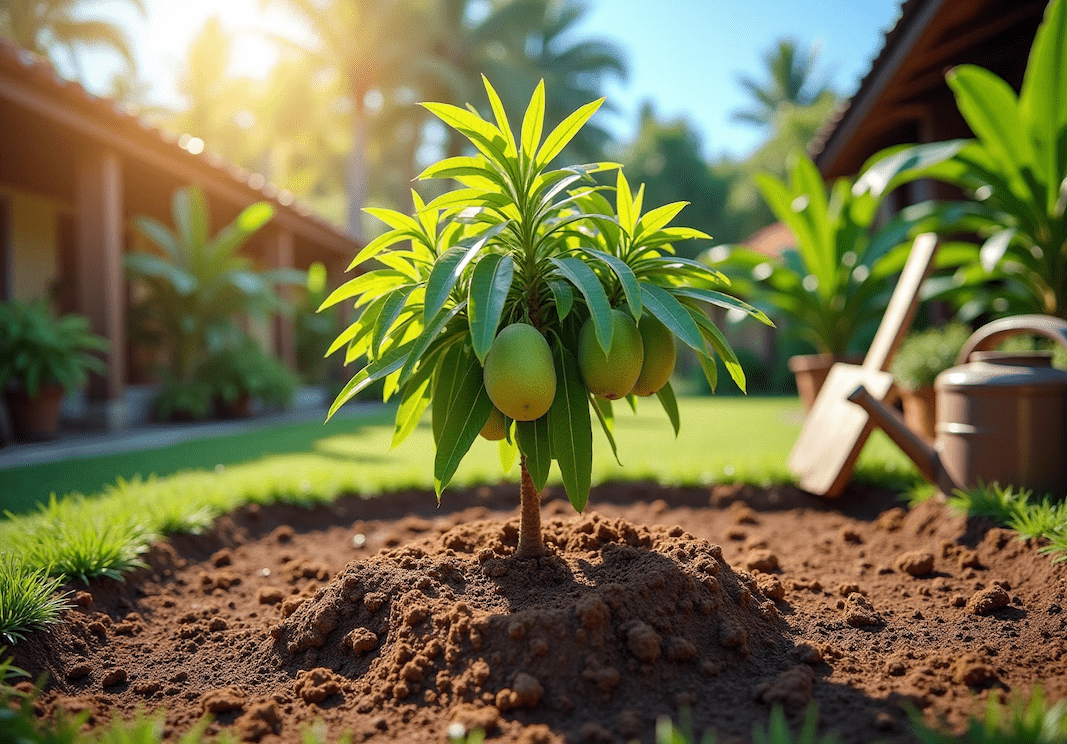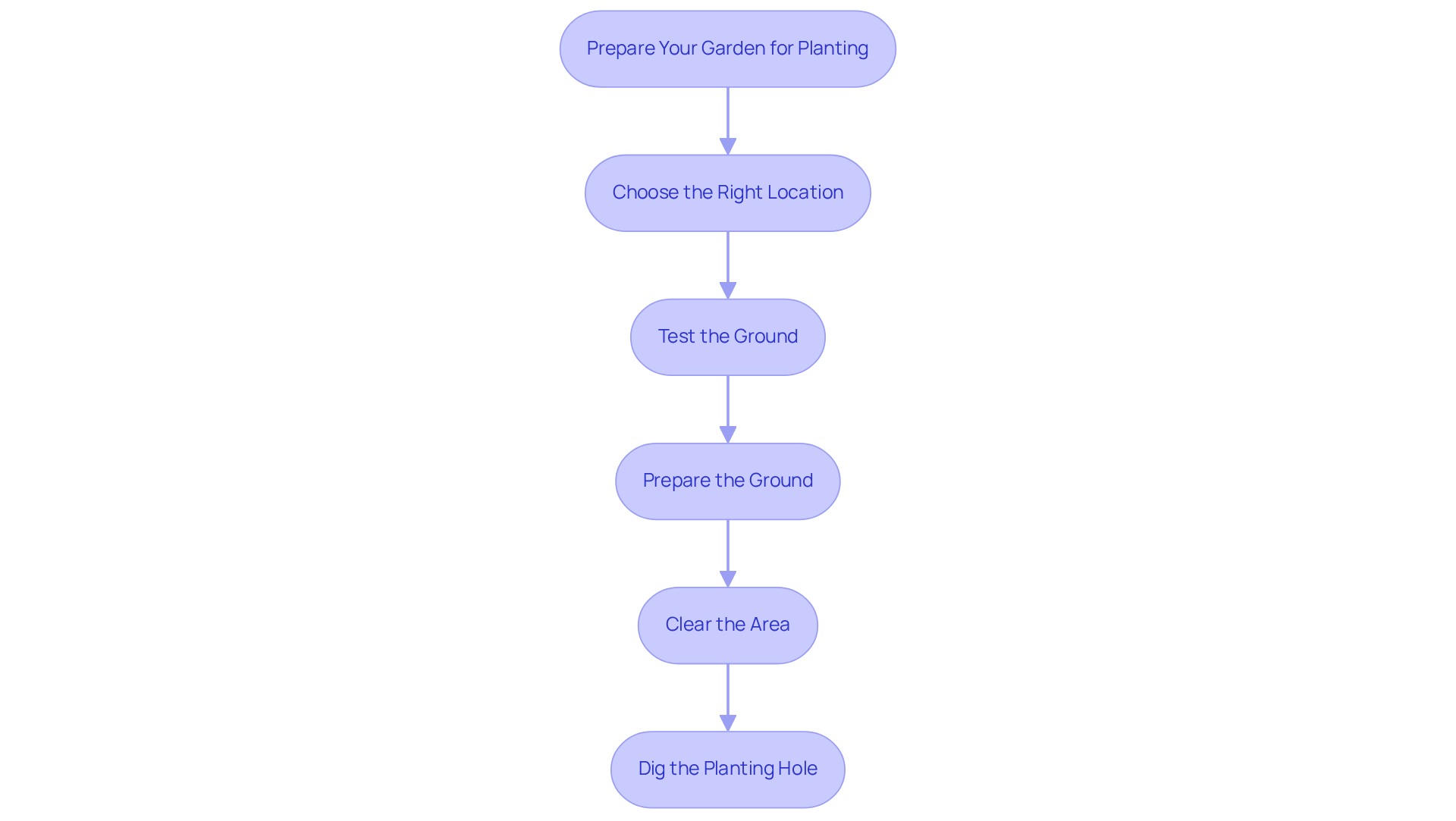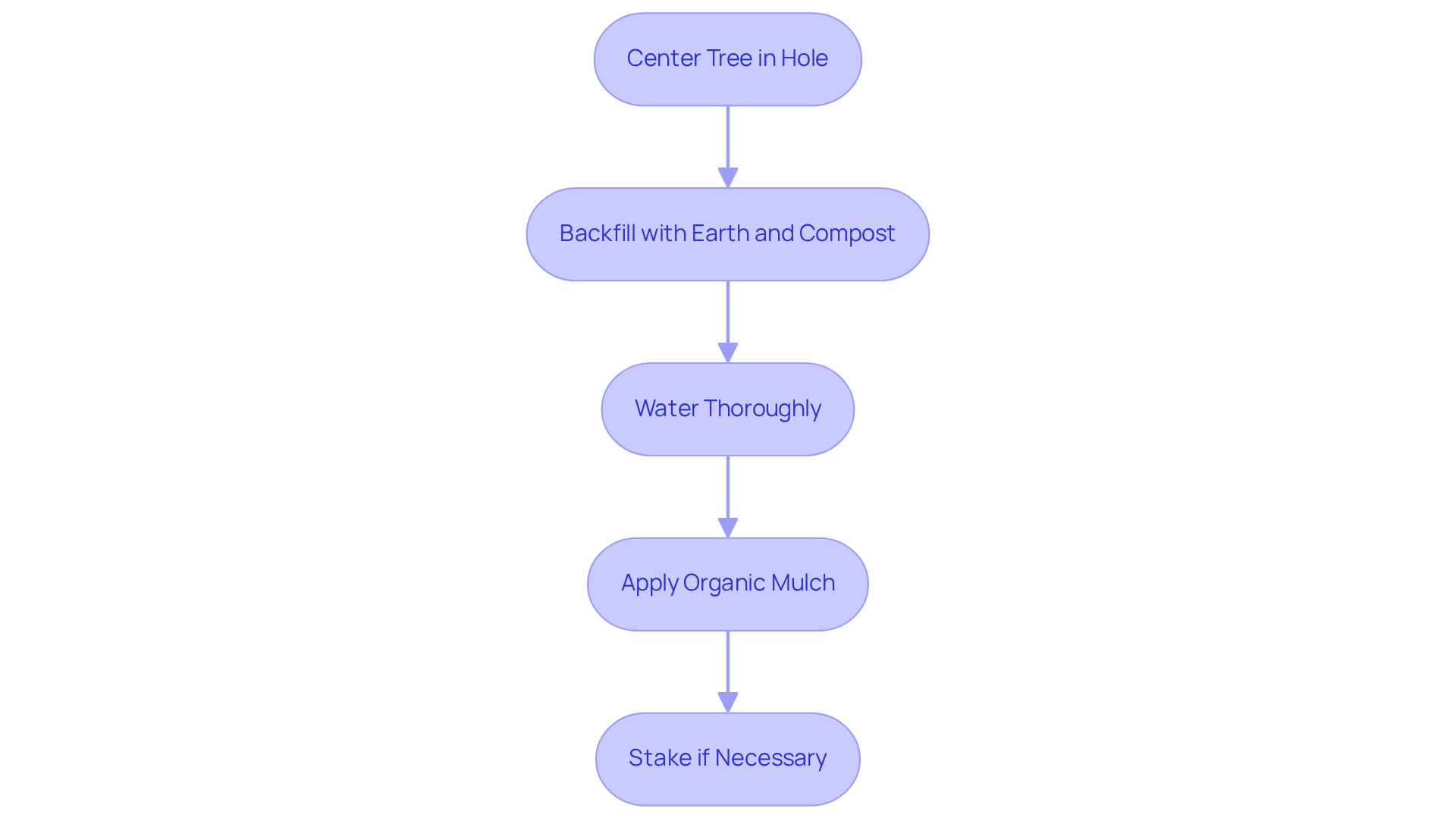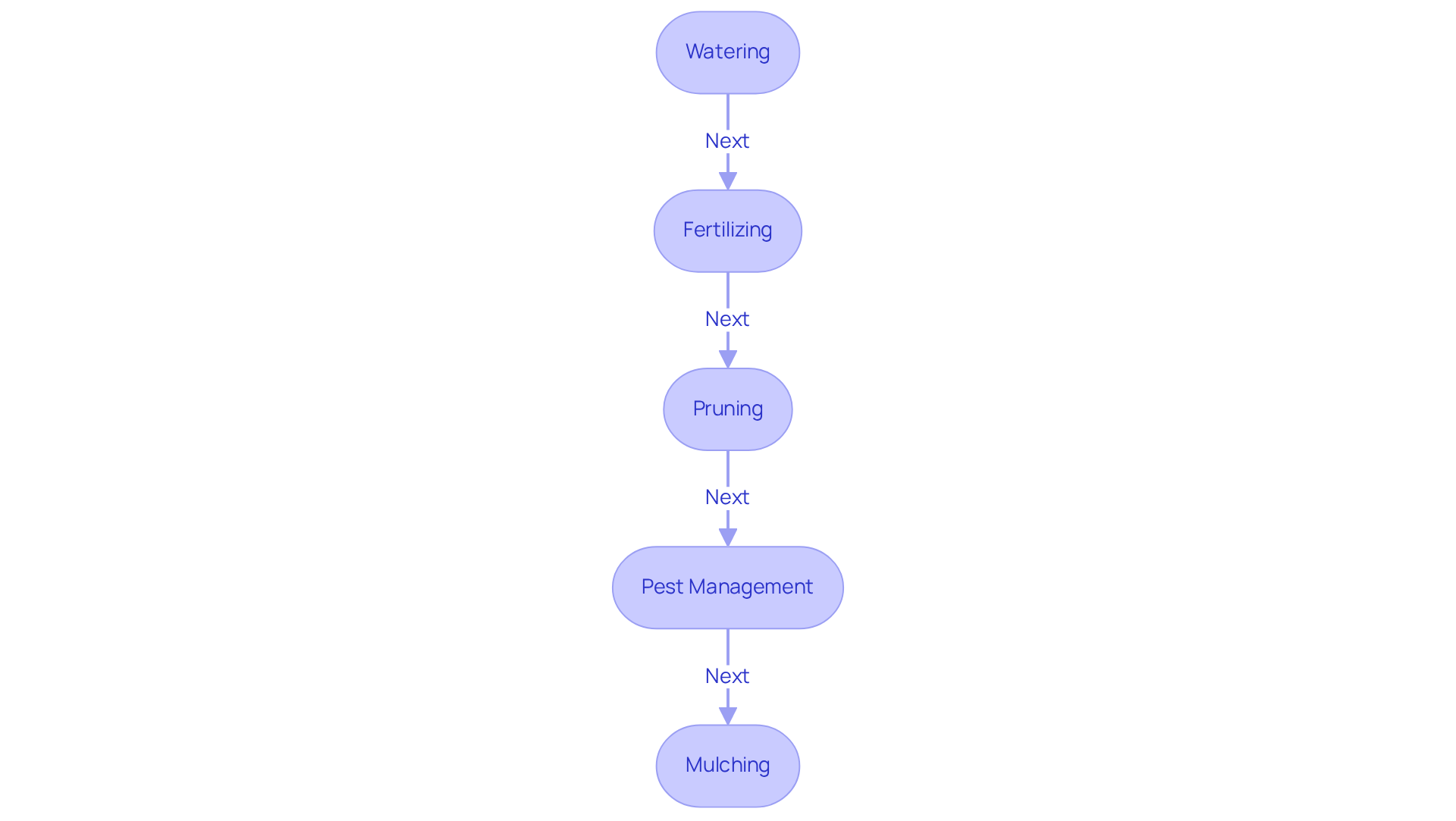
Baptiste Mango Tree: Steps for Successful Planting and Care
Share
Planting a Baptiste mango tree can transform any garden into a tropical paradise; however, achieving success requires more than merely placing a seedling in the ground. This guide explores the essential steps for planting and nurturing these cherished fruit trees
Thinking about growing a mango tree in your garden?
Explore Baptiste Mango Tree at Everglades Farm - shipped directly from Florida.
Prepare Your Garden for Planting
-
Choose the Right Location: Selecting a location that receives full sunlight for at least 6 to 8 hours daily is essential for the robust development of mango plants, which thrive in bright conditions. Additionally, it is important to ensure the area is protected from strong winds, as these can harm young plants and hinder their growth. Consider incorporating Everglades Farm's Fast-Growing Plants collection, which includes varieties that can enhance your garden's productivity alongside your mango plant.
-
Test the Ground: Conducting a test to assess pH levels and nutrient content is crucial. Mango plants thrive in slightly acidic to neutral ground, ideally with a pH range of 5.5 to 7.5. Understanding your land's composition is vital for enhancing growth and fruit yield. Utilizing high-quality fertilizers from Everglades Farm can further improve your soil, ensuring your fruit plant obtains the necessary nutrients for vigorous development.
-
Prepare the Ground: Amending the soil with organic matter, such as compost or well-rotted manure, enhances drainage and fertility. Well-draining soil is crucial to avoid root decay, which can be detrimental to fruit-bearing plants. Everglades Farm provides a variety of fertilizers specifically designed to improve soil quality and promote healthy plant development, particularly for tropical fruit plants.
-
Clear the Area: Removing any weeds, rocks, or debris from the planting site minimizes competition for nutrients and water, enabling your fruit-bearing plant to establish itself more effectively.
-
Dig the Planting Hole: Creating a hole that is three times wider than the root ball of the mango plant and equally deep allows the roots to spread easily, establishing a strong foundation for healthy growth. By following these steps and utilizing Everglades Farm's diverse offerings, including tropical fruit plants and fast-growing greenery, you can create an ideal environment for the baptiste mango tree.

2. Plant the Baptiste Mango Tree
-
Place the Baptiste mango tree by centering it in the planting hole, ensuring that the top of the root ball is level with the surrounding earth. This positioning is crucial for optimal root development, as it allows the roots to spread and establish effectively.
-
Backfill the hole around the baptiste mango tree by carefully filling it with the original earth and incorporating compost to enhance nutrient content. It is important to gently tamp down the earth to eliminate air pockets, which can hinder growth. Effective backfilling is essential for the establishment and overall health of the baptiste mango tree, ensuring it receives the necessary support as it grows.
-
Water thoroughly the baptiste mango tree after planting to irrigate the plant deeply and help settle the soil around the roots. Ensure that the water penetrates the root zone, promoting strong establishment. Sufficient watering is essential during the early development phase, as it supports the plant’s initial growth and resilience.
-
Mulch the area around the baptiste mango tree: Apply a layer of organic mulch around the base of the baptiste mango tree, keeping it a few inches away from the trunk. This practice helps retain moisture, suppress weeds, and regulate soil temperature, creating an optimal environment for growth. The benefits of mulching are significant, as it contributes to healthier soil and reduced competition from weeds.
-
Stake the baptiste mango tree (if necessary): If the baptiste mango tree is tall or situated in a windy area, it may be beneficial to stake it for support until it establishes a robust root system. Proper staking can prevent damage and ensure the plant grows upright, providing stability as it matures.

3. Care for Your Mango Tree
-
Watering: Regular irrigation of the mango plant is essential. Allow the top 2-3 inches of soil to dry out between waterings. During dry spells, ensure the tree receives deep watering once a week to promote healthy root development.
-
For optimal growth of the baptiste mango tree, applying a balanced fertilizer every 6-8 weeks during the growing season is recommended. Fertilizers high in potassium are especially beneficial, as they promote flowering and fruiting. Research indicates that effective soil treatments can significantly boost fruit yield, with specific nutrient applications enhancing both fruit quality and quantity. For example, applying:
- 100 g of Zinc sulphate
- 50 g of Copper sulphate
- 50 g of Boric acid
has been shown to improve mango yield and nutritional quality.
-
Pruning: Lightly trimming the plant is necessary to remove dead or diseased branches and to shape it for better air circulation and sunlight penetration. The optimal period for pruning is after harvest, which helps preserve the plant's health and productivity.
-
Pest Management: Regularly monitor for common pests such as aphids and mealybugs. If infestations occur, natural remedies like insecticidal soap or neem oil can effectively control these pests without harming the plant.
-
Mulching: Maintaining a layer of mulch around the base of the plant is crucial for conserving moisture and suppressing weeds. Renew the mulch as necessary to ensure its effectiveness in protecting the ground and promoting plant health.

4. Troubleshoot Common Mango Tree Issues
-
Yellowing Leaves: Yellowing foliage on fruit plants often indicates excessive watering or nutrient shortages. To address this, check the soil moisture levels; if the soil is consistently wet, reduce watering. Additionally, consider applying a balanced fertilizer to replenish essential nutrients, as deficiencies can lead to poor leaf health. Research indicates that approximately 30% of baptiste mango tree plants experience yellowing leaves due to nutrient deficiencies, highlighting the importance of proper care.
-
Dropping Fruit: Premature fruit drop can occur due to stress factors such as drought or over-fertilization. To mitigate this, ensure the plant receives consistent watering, particularly during dry spells. Avoid excessive fertilizer application, as this can lead to nutrient imbalances that stress the plant. As highlighted by researcher Shamsheer ul haq, comprehending the environmental elements influencing fruit-bearing plants is essential for optimizing production.
-
Pest Infestations: Regular inspections of the leaves are crucial for early detection of pests. Look for signs such as sticky residue or webbing, which may indicate infestations. If pests are present, treat the plant with insecticidal soap or neem oil to effectively manage the problem. The economic lifespan of a baptiste mango tree exceeds 35 years, which makes it essential to protect the baptiste mango tree from pests to ensure long-term productivity.
-
Fungal Diseases: Black spots on leaves may suggest the presence of anthracnose, a common fungal disease. To combat this, enhance air circulation around the plant by trimming dense foliage. If the issue continues, use an appropriate fungicide to safeguard the plant from additional harm. Providing appropriate maintenance can avert up to 40% of these plants from being impacted by fungal ailments.
-
Poor Development: If your mango plant shows limited development, it may be time to reevaluate the earth quality and drainage. Amend the soil with organic matter to enhance its structure and fertility. Ensure the plant is situated to absorb sufficient sunlight, as inadequate light can impede development and fruit production. Everglades Farm offers professional-grade fertilizers designed specifically for fruit trees, which can enhance growth and yield, addressing common challenges faced by gardeners.
Conclusion
Successfully planting and caring for a Baptiste mango tree involves a series of well-defined steps that ensure optimal growth and fruit production. By following the guidelines outlined in this article, gardeners can create the ideal environment for their mango trees to thrive, from selecting the right location and preparing the soil to implementing effective care techniques.
Key points discussed include:
- The importance of sunlight
- Proper soil conditions
- Consistent watering practices
Additionally, understanding how to troubleshoot common issues such as:
- Yellowing leaves
- Pest infestations
- Fungal diseases
is crucial for maintaining a healthy tree. Regular monitoring and appropriate interventions can significantly enhance the tree's productivity and longevity.
In essence, nurturing a Baptiste mango tree is a rewarding endeavor that requires attention to detail and a commitment to ongoing care. By applying the insights shared in this guide, gardeners can cultivate not only a fruitful tree but also a deeper appreciation for the art of gardening. Embrace the journey of growing your mango tree and enjoy the sweet rewards it brings!
Grow Your Own Sweet Mangoes Today!
Order from Everglades Farm and start your journey to a fruitful garden with our premium mango trees.
Frequently Asked Questions
What is the ideal location for planting mango plants?
The ideal location for planting mango plants is an area that receives full sunlight for at least 6 to 8 hours daily and is protected from strong winds.
Why is it important to test the ground before planting?
Testing the ground is important to assess pH levels and nutrient content, as mango plants thrive in slightly acidic to neutral soil with a pH range of 5.5 to 7.5.
How can I improve the soil for mango plants?
You can improve the soil by amending it with organic matter such as compost or well-rotted manure to enhance drainage and fertility.
What should I do to prepare the area before planting?
You should clear the area of any weeds, rocks, or debris to minimize competition for nutrients and water.
How deep and wide should the planting hole be for a mango plant?
The planting hole should be three times wider than the root ball of the mango plant and equally deep to allow the roots to spread easily.


